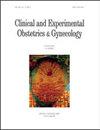Efficacy Analysis of Cervical Cerclage in the Treatment of Cervical Insufficiencies
IF 0.6
4区 医学
Q4 OBSTETRICS & GYNECOLOGY
引用次数: 0
Abstract
Background: This study aimed to assess the efficacy and safety of laparoscopic and transvaginal cervical cerclage treatments in patients with cervical insufficiency before and during pregnancy. Methods: A total of 70 patients diagnosed with cervical insufficiency and undergoing cervical cerclage at the Second Affiliated Hospital of Xinjiang Medical University between January 2020 and December 2022 were included. The patients were divided into three groups based on different surgical methods: transvaginal loop during pregnancy (Group 1, n = 30), transabdominal loop before pregnancy (Group 2, n = 20), and transabdominal loop during pregnancy (Group 3, n = 20). The groups were compared in terms of general clinical data, operation time, intraoperative bleeding, hospital stay, delivery gestational weeks, preterm delivery rate, prolonged gestational weeks, and neonatal births. Results: (1) There were no statistically significant differences in age, pregnancy, delivery, number of miscarriages, cervical length, and history of midterm pregnancy loss among the three groups (p > 0.05). (2) Prolonged gestational week, delivery gestational week, term delivery, and neonatal birth weight were higher in Groups 2 and 3 compared to Group 1, with statistically significant differences (p < 0.05). There was no statistically significant difference (p > 0.05) when comparing Group 2 and Group 3. Premature rupture of membranes and preterm delivery were higher in Group 1 compared to Groups 2 and 3, with statistically significant differences (p < 0.05). There was no statistically significant difference when comparing Group 2 and Group 3 (p > 0.05). (3) The amount of surgical bleeding and surgical time showed statistically significant differences (p < 0.05) among the three groups. Group 1 had more surgical bleeding than Groups 2 and 3, with statistically significant differences (p < 0.05). When comparing Group 2 and Group 3, Group 3 had more surgical bleeding than Group 2, with a statistically significant difference (p < 0.05). Group 2 had a shorter surgical time than Group 1 and Group 3, with statistically significant differences (p < 0.05). When comparing Group 1 and Group 3, Group 3 had a longer surgical time than Group 1, with a statistically significant difference (p < 0.05). There was no statistically significant difference in hospital stay when comparing three groups (p > 0.05). Conclusions: Laparoscopic cervical cerclage is a safe and effective treatment option, yielding better pregnancy outcomes than transvaginal cervical cerclage, particularly for patients with previous failed transvaginal cerclage. Preconception laparoscopic cervical cerclage carries lower surgical risks and should be considered for clinical application.宫颈环扎术治疗颈虚的疗效分析
背景:本研究旨在评估腹腔镜和经阴道宫颈环切术治疗孕前和孕期宫颈功能不全患者的有效性和安全性。方法:选取2020年1月至2022年12月在新疆医科大学第二附属医院诊断为宫颈功能不全并行宫颈环切术的患者70例。根据手术方式的不同,将患者分为妊娠期经阴道袢(组1,n = 30)、妊娠前经腹袢(组2,n = 20)、妊娠期经腹袢(组3,n = 20)三组。比较两组患者的一般临床资料、手术时间、术中出血、住院时间、分娩妊娠周数、早产率、延长妊娠周数和新生儿出生数。结果:(1)三组患者在年龄、妊娠、分娩、流产次数、宫颈长度、中期流产史等方面差异均无统计学意义(p >0.05)。(2) 2、3组延长妊娠周、分娩妊娠周、足月分娩、新生儿出生体重均高于1组,差异有统计学意义(p <0.05)。差异无统计学意义(p >0.05)。1组胎膜早破、早产发生率高于2、3组,差异有统计学意义(p <0.05)。2组与3组比较,差异无统计学意义(p >0.05)。(3)手术出血量、手术时间差异有统计学意义(p <0.05)。1组手术出血多于2、3组,差异有统计学意义(p <0.05)。2组与3组比较,3组手术出血多于2组,差异有统计学意义(p <0.05)。组2手术时间短于组1、组3,差异有统计学意义(p <0.05)。1组与3组比较,3组手术时间较1组长,差异有统计学意义(p <0.05)。三组患者住院时间差异无统计学意义(p >0.05)。结论:腹腔镜宫颈环切术是一种安全有效的治疗选择,妊娠结局优于经阴道宫颈环切术,特别是对于既往经阴道环切术失败的患者。孕前腹腔镜宫颈环切术手术风险较低,应考虑临床应用。
本文章由计算机程序翻译,如有差异,请以英文原文为准。
求助全文
约1分钟内获得全文
求助全文
来源期刊
CiteScore
0.50
自引率
0.00%
发文量
241
审稿时长
1 months
期刊介绍:
CEOG is an international, peer-reviewed, open access journal. CEOG covers all aspects of Obstetrics and Gynecology, including obstetrics, prenatal diagnosis, maternal-fetal medicine, perinatology, general gynecology, gynecologic oncology, uro-gynecology, reproductive medicine, infertility, reproductive endocrinology, sexual medicine. All submissions of cutting-edge advances of medical research in the area of women''s health worldwide are encouraged.

 求助内容:
求助内容: 应助结果提醒方式:
应助结果提醒方式:


